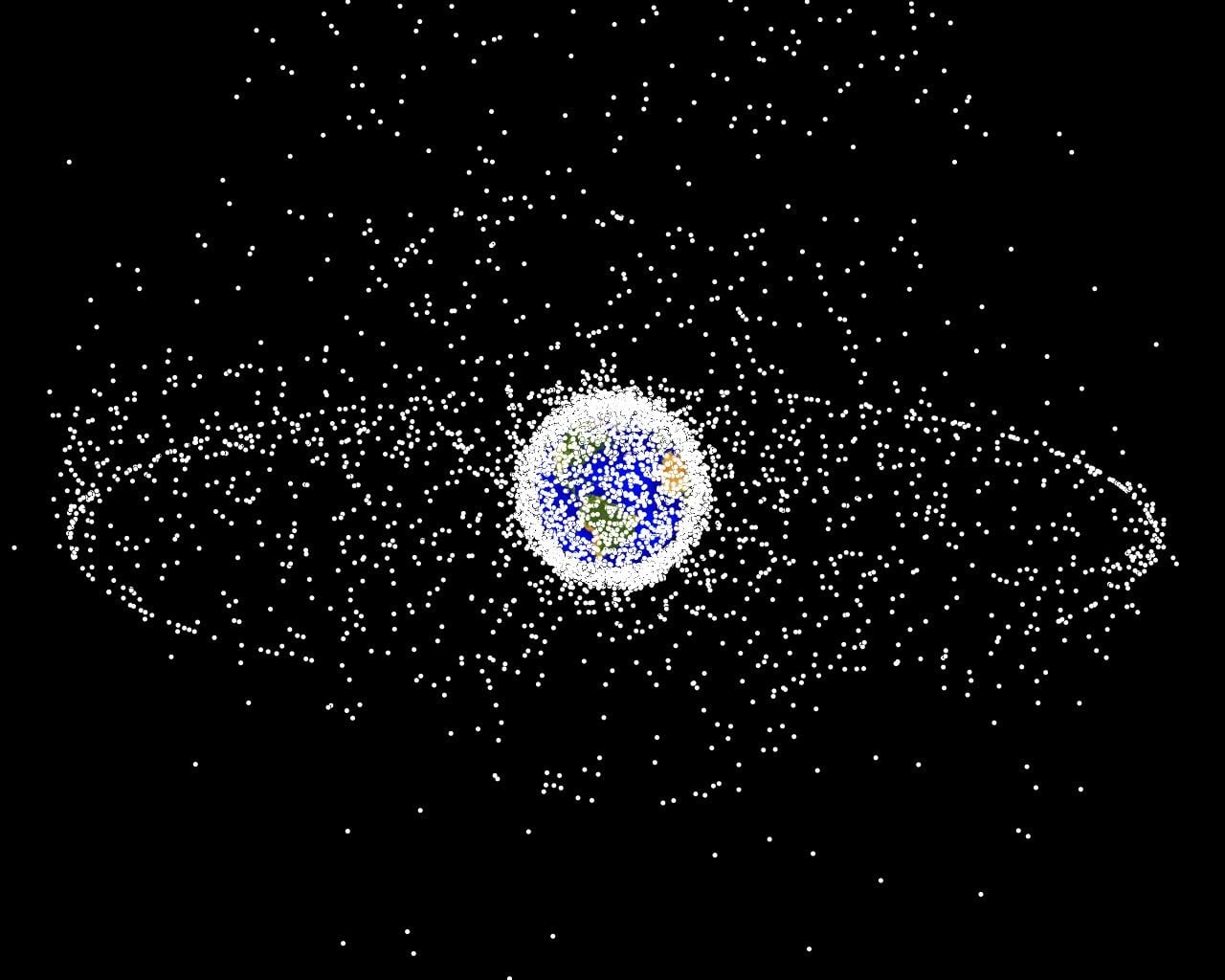The satellite population in Low-Earth Orbit (LEO) is not an open book. While data on many satellites is public, others are shrouded in secrecy, and information is incomplete for others. New research shows how observers can determine satellite shapes by watching them occult background stars.
There are thousands of satellites in LEO, a region defined as below an altitude of 2,000 km (1,200 mi). Most of our satellites and artificial space objects are in this region. Many of these are now defunct, adding to the burden of space debris. The area is clogged, and collisions are becoming more likely. New research shows how astronomers can use a satellite's occultation of background stars to determine their shape and what type of operations it might be engaged in. A better understanding of satellites in LEO is critical to understanding how crowded it's getting and what can be done about it.
The research, "Classification of LEO Satellites Using Occultations of Background Stars," will be published in the Royal Astronomical Society Techniques and Instruments. The lead author is Benjamin Cooke from the Centre for Space Domain Awareness at the University of Warwick in the UK. The paper is available at arxiv.org.
Observing Resident Space Objects (RSOs) in Low Earth Orbit (LEO) is a rapidly expanding field," the authors write. "The number of objects in LEO, both active and inactive satellites, alongside rocket bodies and various debris, is increasing exponentially, and will continue to do so. The research is a proof-of-concept simulation of satellite detection involving two broad shapes: boxwing and square.
"Boxwing satellites are symmetrical, with a central, rectangular body, and two extended wings, whereas square satellites are comparable, but without the extended wing structures," the authors explain.
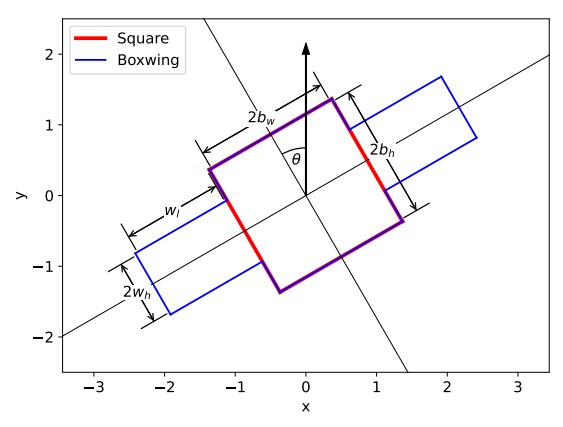 This figure shows how the two broad satellite shapes are detected. "A square satellite (red) is defined by two parameters (𝑏𝑤 and 𝑏ℎ) and a boxwing satellite (blue) is defined by four parameters (𝑏𝑤, 𝑏ℎ, 𝑤𝑙 and 𝑤ℎ)," the authors write. Image Credit: Cooke et al. 2025, RASTI.
This figure shows how the two broad satellite shapes are detected. "A square satellite (red) is defined by two parameters (𝑏𝑤 and 𝑏ℎ) and a boxwing satellite (blue) is defined by four parameters (𝑏𝑤, 𝑏ℎ, 𝑤𝑙 and 𝑤ℎ)," the authors write. Image Credit: Cooke et al. 2025, RASTI.
Existing methods of detecting RSOs suffer from some significant drawbacks. Radio observations are typically used but rely on an RSO's radar cross section (RCS). An object's RCS is not its actual size. The RCS can be minimized depending on the materials used and the object's design. Think stealth fighters.
Optical observations are also used, and likewise suffer from limitations. They rely on an RSO reflecting sunlight, which can also be minimized by design and material choices. Also, optical observations can only be carried out during twilight, when an RSO reflects sunlight and the sky is dark.
Sophisticated technologies can help overcome some of the obstacles to radar cross sections and optical observations, but they don't provide immunity.
However, determining satellite shapes by occultation has some advantages.
As an RSO moves across the sky, it temporarily occults background sources, and these occultations can reveal details about the target," the authors write. "The benefit of relying on these occultations is that they are entirely affected by the outline of the object, i.e. the size and shape.
That means any efforts to reduce a satellite's RCS or reflectivity have no effect. The object doesn't need to reflect sunlight, which can make the occultation method very powerful, even in the face of deliberate attempts to conceal a satellite's true identity.
"It is notable, however, that the technique is not available while the target is sunlit, as the reflected light from the target would obscure the occultations," the authors write.
In their simulations, the researchers drew various theoretical satellite shapes in two distinct classes, 'boxwing' and 'square'. All of them were opaque. In the simulations, the satellites crossed a region of the sky with known stellar backgrounds, following different trajectories and speeds but confined to LEO.
The first step in determining the shape is determining the rotation angle. After that, they determine the positions of the satellite's shape edges. In these simulations, they used symmetrical satellites. "Making the assumption that the satellite is symmetrical means that we only have to test edges along one side of the satellite shape, which is then reflected to get the opposite side edge," the authors explain.
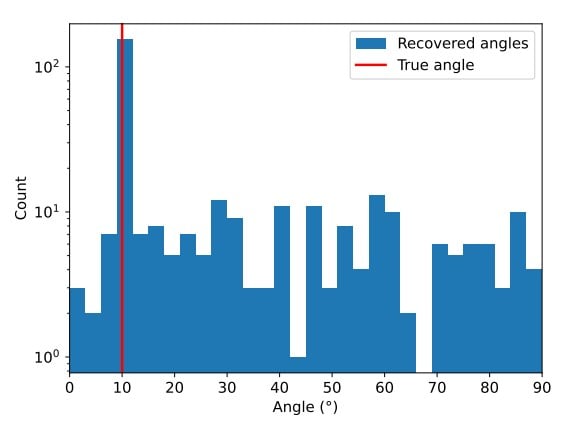 This figure shows the recovered angles for a simulated satellite. "The true rotation value is marked in red and is well recovered as the modal peak in the distribution," the authors write. Image Credit: Cooke et al. 2025, RASTI.
This figure shows the recovered angles for a simulated satellite. "The true rotation value is marked in red and is well recovered as the modal peak in the distribution," the authors write. Image Credit: Cooke et al. 2025, RASTI.
Once the shape edges have been determined, the simulation attempts to fit a square or boxwing shape into the edges. This involves recovering intersection points and determining their distance from the proposed satellite shape edge. "This process leaves us with the best-fitting square and the best-fitting boxwing shape," the researchers write.
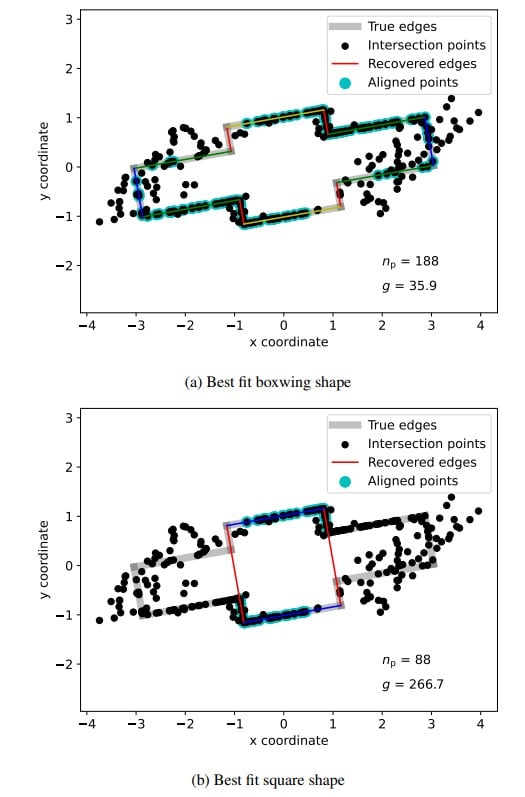 This figure shows the best-fitting boxwing and square fits for the test case (a boxwing satellite). "The grey lines are the true edges, the black points are the intersection points (highlighted cyan when aligned with a true edge), and the coloured lines are the recovered edges (edges reflected across the origin are the same colour)," the authors write. In this case, the boxwing fit is stronger because it has more aligned points. Image Credit: Cooke et al. 2025, RASTI.
This figure shows the best-fitting boxwing and square fits for the test case (a boxwing satellite). "The grey lines are the true edges, the black points are the intersection points (highlighted cyan when aligned with a true edge), and the coloured lines are the recovered edges (edges reflected across the origin are the same colour)," the authors write. In this case, the boxwing fit is stronger because it has more aligned points. Image Credit: Cooke et al. 2025, RASTI.
The researchers simulated 100,000 satellites in their work. When the data isn't strong enough to make a determination, the satellites are designated as either correct, incorrect, or rejected. Square satellites have a slightly worse success rate than boxwings and are also more likely to be rejected. This is probably because they have smaller surface areas. That means fewer intersection points and less robust fits.
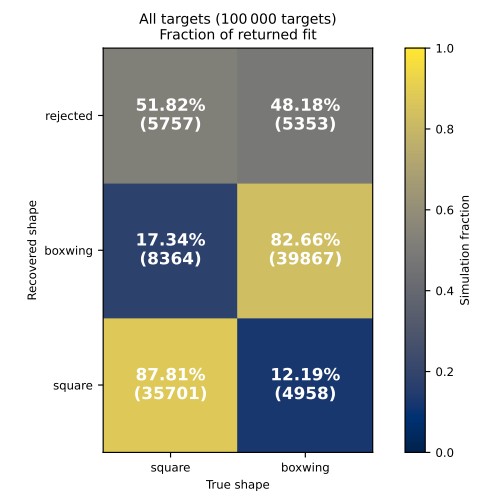 This figure shows the simulated satellites separated by actual shape and their shape as determined by the simulation. Percentages are given as a fraction of the number of satellites of each true classification (i.e. totals are summed vertically). Both shape types were successfully retrieved in more than 80% of cases. Image Credit: Cooke et al. 2025, RASTI.
This figure shows the simulated satellites separated by actual shape and their shape as determined by the simulation. Percentages are given as a fraction of the number of satellites of each true classification (i.e. totals are summed vertically). Both shape types were successfully retrieved in more than 80% of cases. Image Credit: Cooke et al. 2025, RASTI.
The authors claim that this method is theoretically sound, but for now, it is out of reach due to current technology.
"However, due to the difficulty of the technique (specifically the small size of LEO objects and their large speeds) achieving a high classification success rate requires very fast exposure times (hundreds to thousands of frames per second) and dense stellar fields (hundreds of stars along the LEO object's path), putting the practical limits of the technique beyond the capabilities of current systems," they write in their conclusion.
They also explain that while in their simulations, the LEO satellites were all at the same altitude, that's not the case in real life, adding another layer of complexity. Since this is a proof-of-concept study, they didn't use altitude as a variable.
While the research shows the technique's viability in the future, the limitations make it impractical, at least for now.
"These limits are sufficiently extreme as to be generally beyond the scope of current optical observation systems, but we verify the method as a potential tool for future observatories," the authors conclude.
 Universe Today
Universe Today
